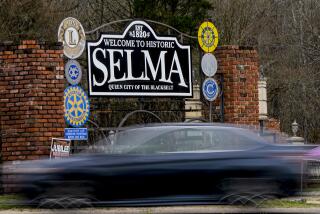Memories of Selma and ‘Bloody Sunday’: ‘They came with nightsticks’

Amelia Boynton Robinson, more than a century old and a matriarch of the civil rights movement, recalls how she was beaten, tear-gassed and left for dead in Selma, Ala., 50 years ago on the day that came to be known as “Bloody Sunday.”
They became iconic images of the civil rights movement: A middle-aged black woman tear-gassed and beaten and slumped unconscious on the side of the road. A white Alabama state trooper, billy club in hand, stands above her. In another photo, a young man cradles her body in his arms.
Amelia Boynton Robinson, the woman in those photos, had helped galvanize hundreds of activists to cross the Edmund Pettus Bridge on March 7, 1965 — part of a march from Selma to Montgomery to demand their civil rights. Helmeted law enforcement officers pummeled the peaceful demonstrators on what became known as “Bloody Sunday.”
“They came with horses,” Boynton Robinson recalled. “They came with nightsticks.”
She is now a centenarian — conflicting sources put her age at 104 to 109 — and devotees lovingly refer to her as “Queen Mother.”
“I was taught to love people, to excuse their hate and realize that if they get the hate out of them, that they will be able to love,” Boynton Robinson said during a recent trip to Los Angeles. “After Bloody Sunday people began to wake up.… and those who have arisen because of our Bloody Sunday have excelled.”
The matriarch of the civil rights movement is physically frail and uses a wheelchair, but she remains perceptive and alert, and her failing health has not dampened her determination to keep pushing for change.
“I was born to lead,” said Boynton Robinson, whose role in the voting rights movement is featured in the film “Selma.” “My parents didn’t look at people as being colored or white.” They treated everyone as equal, she added.
Boynton’s activism began when she was a girl growing up in Savannah, Ga. As young as 9 years old she accompanied her mother in a horse and buggy, distributing leaflets for the Women’s Suffrage Movement. (Women finally got the right to vote with the ratification of the 19th Amendment in 1920.)
At age 14 she attended Georgia State Industrial College for Colored Youth, now Savannah State University. Two years later she started studying under the tutelage of famed African American botanist and inventor George Washington Carver.
Her career would lead to her to becoming a home demonstration agent for the U.S. Department of Agriculture. The job included helping rural women with food preservation and teaching home economics.
“My parents made an example of what they wanted their children to be,” Boynton Robinson said. “My parents never looked down at anybody,” and they believed every individual should be treated and respected as royalty, she said.
Boynton Robinson became a registered voter in 1932, but many blacks, particularly in the South, remained disenfranchised due to obstacles, such as poll taxes and literacy tests, enforced by state and local authorities. The Selma establishment was known to be among the most egregious in barring blacks from the polls.
Along with her husband, Sam, she pushed for black rights, and their house on Lapsley Street in Selma became a meeting place for organizers in the movement. Planning sessions for the march on the Edmund Pettus Bridge were held in that house.
The Selma march was organized to protest the fatal shooting a few days earlier of a young African American church deacon named Jimmie Lee Jackson by an Alabama state trooper, and the general issue of black disenfranchisement across much of the South.
During a meeting in Malibu with middle school journalism students, the veteran activist vividly recalled how law enforcement officials, armed with tear gas, were determined not to let the activists march to Montgomery. She recounted how when demonstrators refused to disperse, the attack began.
“People were running because they were beating you,” Boynton Robinson said. “I mean they were beating everything. I just stood still.”
An officer ordered her to run. She asked, “Why, what for?” That’s when he struck her on the shoulder, then at the base of her neck, knocking her unconscious.
Troopers dragged her to the side of the road, leaving her for dead.
As Boynton Robinson later learned, when Selma’s Sheriff Jim Clark was told of her presumed demise he was less than sympathetic.
“He said, ‘If she’s dead, let her alone and let the buzzards eat her,’” Boynton Robinson said.
Fellow activists came to her aid and an ambulance eventually took her to a hospital.
The images of the atrocities that day triggered shock and outrage across the globe.
When Boynton Robinson became aware of the magnitude of the malfeasance that occurred on Bloody Sunday, it intensified her will “to do better and go farther and ... to help the people to become registered and voters,” said the activist, who in 1964 was the first black woman in Alabama to seek a seat in Congress.
According to published material, in the weeks after the march a group of U.S. congressmen met with the Rev. Martin Luther King Jr. and other civil rights leaders at Boynton Robinson’s home to produce the first draft of the Voting Rights Act. Boynton Robinson was at the White House when President Lyndon B. Johnson signed the act into law in August 1965.
Although census data shows that turnout among voting-age African Americans in presidential elections has vastly improved in recent years — in part due to President Obama and his campaign’s community mobilization drive — Boynton Robinson believes there is still a sense of apathy among the black electorate.
“They have gone back to sleep,” she said. She appealed to today’s generation to embrace the lessons of the struggle and not take suffrage for granted.
“I am still determined that these young people will realize that a voteless people is a hopeless people,” she told the students, and later added: “If they keep doing what Dr. King and the others were doing, we will not regret.... because we have paved the way for them to follow.”
Twitter: @AMSimmons1
Los Angeles Times videographer Albert Lee contributed to this report.
More to Read
Start your day right
Sign up for Essential California for news, features and recommendations from the L.A. Times and beyond in your inbox six days a week.
You may occasionally receive promotional content from the Los Angeles Times.







